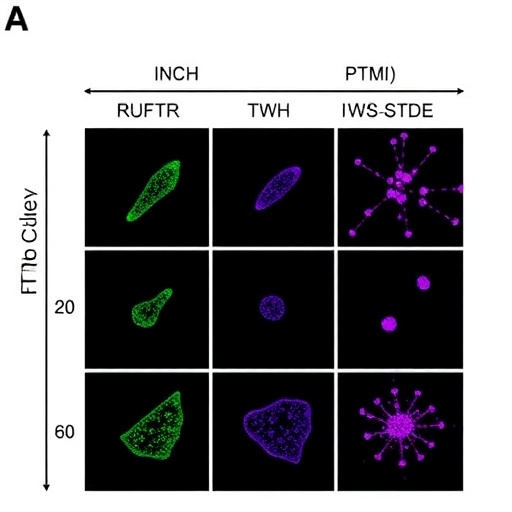A groundbreaking study published in the International Microbiology journal sheds light on the innovative use of microemulsion formulations to combat the virulence factors associated with multi-resistant strains of Mycoplasma gallisepticum, a notorious pathogen affecting poultry. The research, led by Hosny et al., highlights a promising avenue for addressing the challenges of antibiotic resistance, which poses a significant threat to poultry health and production worldwide. As multi-drug-resistant bacteria become increasingly prevalent, exploring alternative treatment strategies becomes imperative.
Mycoplasma gallisepticum, a species of bacteria known for its role in chronic respiratory diseases in poultry, is particularly challenging due to its ability to develop resistance to conventional antibiotics. This adaptation threatens the poultry industry, creating an urgent need for effective alternatives. The research team conducted in-depth investigations into various microemulsion formulations, which are nanoscale emulsions known for their stability and ability to encapsulate both hydrophilic and hydrophobic substances. The study’s findings suggest that these formulations may exhibit potent antimicrobial activity against resistant bacterial strains.
The innovative microemulsion formulations utilized by Hosny and colleagues consisted of a combination of surfactants and oils that work synergistically to enhance their antibacterial efficacy. The study documents the intricate mechanisms through which these microemulsions can influence viral determinants, effectively reducing the pathogenicity of Mycoplasma gallisepticum. The researchers employed several in vitro experiments to evaluate the effectiveness of these formulations in inhibiting bacterial growth and reducing virulence factors.
One of the key highlights of this research is the ability of microemulsions to penetrate the bacterial cell membrane more effectively compared to traditional antibiotics. This property results from their unique nanoscale structure, which enables them to deliver active compounds directly into the bacterial cells. The study meticulously details how these formulations disrupt the microbial cell envelope, leading to increased permeability and ultimately enhanced antimicrobial action.
In addition to their direct antibacterial effects, the microemulsion formulations used in this study demonstrated an ability to interfere with the bacterial communication systems, often referred to as quorum sensing. This disruption prevents Mycoplasma gallisepticum from coordinating its virulence strategies, impairing its capacity to cause disease. Such insights underscore the potential of microemulsions not only as antibiotics but also as modulators of bacterial behavior.
Moreover, the research introduces the concept of synergistic activity among various microemulsion components. By carefully selecting and combining different surfactants and oils, the researchers were able to enhance the overall antimicrobial efficacy beyond what individual components could achieve. This strategy is particularly advantageous in the face of rising antibiotic resistance, providing a multifaceted approach to combat microbial infections.
The encouraging results from the in vitro studies prompted further investigations into the applicability of these microemulsions in real-world settings. Preliminary trials indicated that administering the microemulsion formulations to affected poultry could lead to significant improvements in clinical signs and overall health. The researchers noted that chickens treated with the formulations showed reduced respiratory symptoms and improved recovery rates, which is particularly crucial in commercial poultry operations where productivity is closely linked to animal health.
Adopting microemulsion formulations as an alternative means of managing Mycoplasma gallisepticum infections also contributes to sustainable farming practices. With increasing consumer demand for antibiotic-free meat products, the poultry industry must find innovative ways to maintain animal health without relying heavily on conventional antibiotics. This research opens doors for the development of integrated disease management strategies that align with consumer expectations and public health guidelines.
Furthermore, the study underscores the importance of interdisciplinary collaboration in addressing global health challenges. The researchers integrated expertise from microbiology, pharmaceutical sciences, and agricultural practices to create a holistic approach to studying bacterial infections in poultry. This collaborative framework may serve as a template for future research initiatives aimed at developing effective alternatives to antibiotics across various sectors.
In conclusion, the findings presented by Hosny et al. offer hope for a more resilient poultry industry by illustrating the potential of microemulsion formulations to combat multi-resistant Mycoplasma gallisepticum. This innovative approach not only addresses an urgent health threat but also aligns with broader initiatives to curb antibiotic resistance globally. As such, the research raises important questions for future investigations, including the long-term applicability of microemulsions, their potential side effects, and the mechanisms underlying their efficacy.
As the poultry industry grapples with the challenge of antibiotic resistance, research such as this highlights the necessity of adaptability and innovation. Emphasizing the importance of sustainable practices, the study points towards a future where poultry health can be maintained through alternative strategies, ultimately benefiting consumers, producers, and the ecosystem as a whole.
In an era where the consequences of antimicrobial resistance loom larger than ever, the findings of this research underline a significant step forward. The integration of nanotechnology through microemulsion formulations exemplifies how science can pave the way towards more effective and sustainable solutions for complex agricultural challenges.
As the poultry sector continues to evolve, ongoing research into the use of microemulsions will be critical. The possibility of translating these findings into practical applications could revolutionize how poultry diseases are managed and treated, setting a precedent for new research directions in animal health and disease management.
By harnessing the synergistic effects of microemulsion technology, the research reinforces the notion that groundbreaking solutions often come from interdisciplinary collaboration and innovative thinking. Mycoplasma gallisepticum may represent a formidable adversary, but with ingenuity, resilience, and an unwavering commitment to scientific exploration, it is a challenge that can be met head-on.
Subject of Research: Microemulsion formulations and their effects on Mycoplasma gallisepticum.
Article Title: Highlight on the synergistic effect of different microemulsion formulations on the virulence determinants of multi-resistant Mycoplasma gallisepticum recovered from poultry.
Article References:
Hosny, R.A., Masry, D.M.A.E., Saad, A.S.A. et al. Highlight on the synergistic effect of different microemulsion formulations on the virulence determinants of multi-resistant Mycoplasma gallisepticum recovered from poultry. Int Microbiol (2025). https://doi.org/10.1007/s10123-025-00712-0
Image Credits: AI Generated
DOI: https://doi.org/10.1007/s10123-025-00712-0
Keywords: Mycoplasma gallisepticum, microemulsion formulations, antibiotic resistance, poultry health, synergistic effects.




